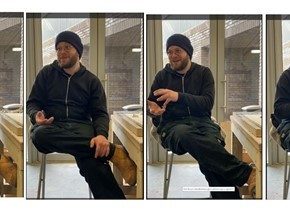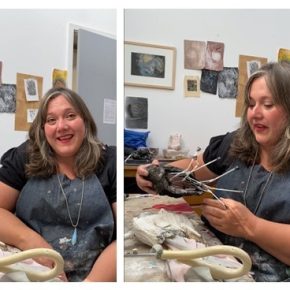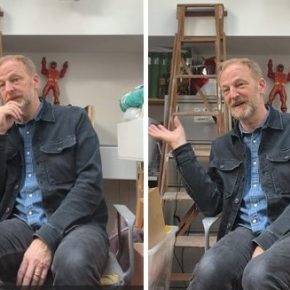Studio Conversation with Aeneas Wilder
Don’t touch it, it is not fixed at all, you can’t take out any single piece. This is one of a series of works I’ve been working on over for many, many years. This is the latest in the series made for a hotel in Kyoto.
Is quite hypnotic.
Yeah? I’ll show you some things assuming you haven’t seen many images of mine here, I can show you that I make small scale maquettes and then a larger scale variation. Small scale ones can’t be made without gluing it together. This work has to be sitting on the floor, there’s no point in gluing this because I can’t then do all the different permutations.

The installation here in the studio is more or less this piece in Osaka, and these are the same sticks here as are used in the works in these other images also. The same sticks again here.
I’ll show you a video, a really short one. This is in the old Edinburgh Sculpture Workshop, I am cutting all these bits of wood. It took a long time – two weeks nonstop, so I kept this one minute bit of video for the audience to suffer one minute of an industrial process, as I suffered, cutting, and cutting, and cutting. That is me working at ESW, before this new building.
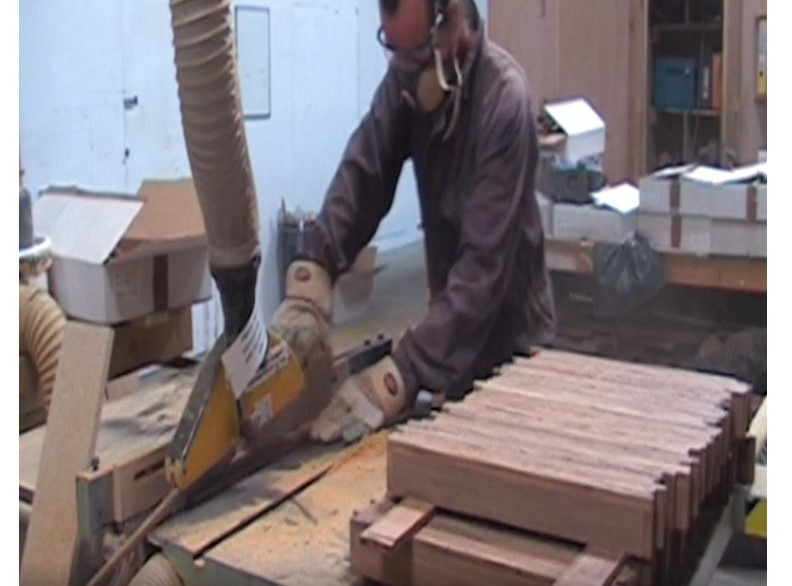
I’ll show this other video quickly – this sculpture was built up of something like eight thousands sticks It was a three-month exhibition and this footage of the collapse of that sculpture was at the end of the exhibition.
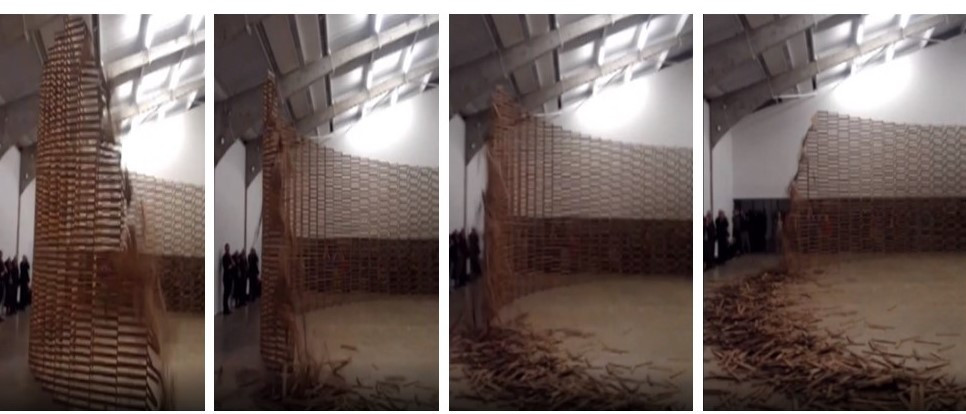
Did you know that this is the way they were going to fall down?
Yeah, yeah, it was not the first time I had done this. They loved it, everybody loves it. And these are exactly the same stick as here, in this particular image. One of these sticks here in the Project Space that I am using now, is somewhere in that video, part of the sculpture.
So, you use again and again the same sticks? What kind of wood is it?
Yes, I do. This is eucalyptus from Indonesia. I’ll tell you the story. A colleague and I organized an outdoor exhibition here in Edinburgh nearly thirty years ago and somebody destroyed my work, in fact many of the other artists’ works also. Drunken people during the festival and such, repeatedly climbing into the exhibition space and smashing things up. It was a bit of a low point, anyway… someone phoned me up: “Aeneas, do you want some wood, I’ve got a van full?” It turns out that two friends were contracted by Edinburgh University to take up the floor of the natural philosophy laboratory as it was being turned into a library – they don’t study natural philosophy anymore – and these friends had filled a van full of parquet flooring getting ready to take it to the dump. Then they phoned me up to see if I wanted to have some sticks because it was quicker to have a third person to help them empty their van, than it was for two of them to take the second load of sticks to the dump. So, I took the sticks. They gave me 18,000 sticks, these pieces of wood I am still using occasionally, like these ones I am working with today.
The other 18,000 sticks are down in the landfill at Seafield. They won’t rot or decay easily. That’s the reason they were used for the laboratory floor, it doesn’t burn easily either. At the time, I didn’t know it was eucalyptus, but I sent a sample to Cambridge, to the tropical plants department or something like that, and they analyzed it, and said that is one of two types of Eucalyptus, probably originating in Indonesia. I was told that they installed that laboratory floor in 1920. So, this material is one hundred years old. One good reason to not glue it together. You can’t buy this material. Why fix it in place with glue when there is so much potential. You can still see bits of black on the wood, the tar they used to stick it down back in the day. When I got this wood it was all covered in tar and I had to clean it, with a special chemical solution. It was a labor of love.
I was in the studio with all these sticks cleaned and back in boxes after yet another vandalized outdoor sculpture project. They sat like that for about six months. And one day I thought, there must be something that I can do with these sticks. And it was myself and Alejandro Lopez – we were in the studio, working late, on a Friday, and I took a box out into what was then the education space and took three sticks and made an equilateral triangle on the floor. Where do you go from there? You just keep adding. I am a precise person, so, I do precise things but I will demonstrate quickly for you… six equilateral triangles make a hexagon, and then six squares can be added onto each hexagonal face, and the shape between the squares… hey more equilateral triangles! So, you just boom, boom, boom and eventually you have a circle. So, once you defined a circle, you think oh, I can put this here, and I could do that again here… you can start grow upwards; you don’t have to grow out. And then that’s it! This is the system, you know.
It was a really odd twenty minutes of my life.

Within about five hours I had built a three dimensional structure of this size, and then another one. The space needed to be clear and ready again for other people to use it on the Monday, so, I though, what do I do, should I pick up every stick and put it back in the box or give it a kick and let it all fall down. And when you do that and it falls, everybody goes: Oooooh.
It was a doing thing, rather than intellectual or academic analysis. There are a lot of things going on in this: it is a play thing, it’s a sculpture, it’s also an installation, it is a form of drawing, it is systems based art and if I kick it, it’s a performance, so it starts to become all these other things: optical art, time based art, video documentation, animation, a theatrical device, it touches on environmental issues, sustainability and so on and I’m going to tell you something that nobody has ever said to me, in all my years, they’ve never written this; it’s a binary system.
Are there any other binary systems you can think of in the world? Your phone is a binary system, your computer is, which I was aware of at the start. With zeros and ones we have everything in the world today, give or take. It is endless. And this system is basically zeros and ones. Equal parts material and space, existence and non-existence. I have had many people tell me it is like house of cards, it’s like dominos, Jenga, Kapla blocks etc., etc. it’s always like this, with the implication is that it’s not valid enough.
Nobody’s ever said: is like a binary system.
Project Space Conversation with Aeneas Wilder on 9 February 2023.
More about Aeneas Wilder’s works here


